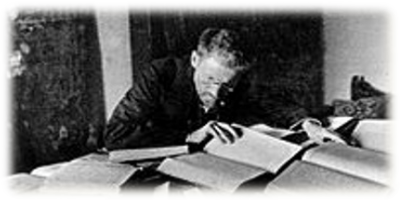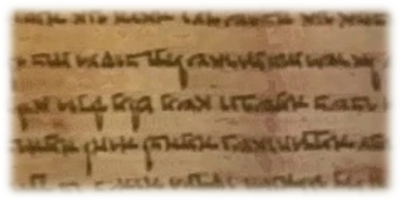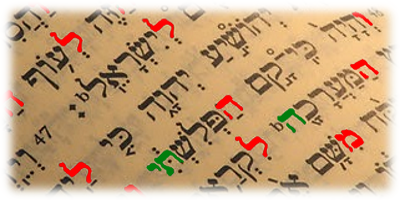Linguistics is defined as “the scientific study of language and its structure.” Science is defined as the “systematic knowledge of the physical or material world gained through observation and experimentation.” While most Hebrew linguists take a very scientific approach to the language, my approach is more from an artistic one. But is the science of linguistics, or any other branch of science, open to a more artistic influence?
The University of Nottingham website’s article, Art versus Science, asks the question, “Are [the arts and sciences] really as distinct as we seem to assume? And if they are, what is the distinction? Do we have a clear definition of each that allows us to see their separation? There is no universal agreement on these questions.” The article goes on to explain that “science requires creative thinking,” which is an art, and that artists “must also learn a technique, sometimes as rigorous and precise as found in any science.”
Two-Letter Root Words
In 1810 William Gesenius published his Hebrew Lexicon and in 1813 his Hebrew Grammar. Because of these works, William Gesenius is credited with being the first to approach the Hebrew language of the Bible from a scientific approach, by examining, comparing and documenting the relationships and meanings of the Hebrew words of the Bible. William Gesenius’ work has been edited and revised many times and other works by other authors have duplicated Gesenius’ work, but any other advancements in Hebrew Philology has seemed to stagnated since the introduction of his work. It’s almost as if Gesenius’ work was considered the final authority on Hebrew philology
In William Gesenius’ Hebrew Grammar he proposed the hypothesis that "a large number of triliteral stems really point to a biliteral base, which may be properly called a root, since it forms the starting-point for several triliteral modifications of the same fundamental idea." Gesenius then cites the following example; "The biliteral root כר (K-R) is the root of כרר (K-R-R), אכר (A-K-R), כור (K-W-R) and כרה (K-R-H), each being related to the idea of "digging." Another example he provides is the biliteral root דך (D-K), the root of דכא (D-K-A), דכך (D-K-K), דוך (D-W-K) and דכה (D-K-H), each being related to the idea of "striking" or "breaking." Other scholars have also proposed this hypothesis, but none has set out to prove or disprove it. I believe this is due to scholars not using enough “art” with their “science.”
About twenty years ago, while working on my Ancient Hebrew Lexicon of the Bible, I independently hypothesized the same possibility, that three-letter Hebrew root words (what Gesenius referred to as “trilateral stems”) were derived from two-letter Hebrew roots (bilateral stems). Over the next ten years I set out to put this hypothesis to the test with my results being published in my Ancient Hebrew Lexicon in 2005. In this lexicon I connected a great number of three-letter root words with, what I believe to be, their roots in two-letter root words.
While my lexicon has been accepted and used by many individuals, Biblical scholars ignore it and criticize it because it does not conform to accepted and proven Hebrew philology. Why are scholars so resistant to investigate new approaches to Biblical Hebrew studies?
I was, in a very small way, involved with the pre-production of the movie documentary Patterns of Evidence: The Exodus. The producer of the film relayed a very interesting and eye-opening story to me. The movie makers interviewed a famous Biblical scholar. They presented to him their extra-ordinary evidence concerning the Exodus of the Israelites from Egypt and the scholar being interviewed responded with a somber countenance and stated that the evidence was interesting, but not conclusive. However, once the camera was turned off his countenance immediately changed to one of excitement and commented that this evidence could change biblical history profoundly. Why did this scholar basically ignore the evidence on camera, yet show great enthusiasm when the camera was turned off? The answer is very simple, he could not be perceived of accepting these radical changes to the paradigm of biblical history, as it would affect his standing as a biblical scholar. It is these kinds of attitudes that prevent the advancement of science and stifles any growth in the field.
So, if Biblical linguists are not willing to push the envelope in new research and studies through the “art” of critical thinking, it is left to the likes of people like me and others to bring about these advancements.
Pictographic Hebrew
Another aspect of my lexicon that has been ignored by Biblical Scholars is my proposal that the letters used to form these two-letter roots (what I call “parent roots” in the lexicon) have meanings based on their original pictographs.
We know for a fact that the Hebrew word for “father” is
אב (av). It is also factual knowledge that the origins of the Hebrew alphabet is the ancient pictographic script and that the Hebrew word for “father” would have been written with two “pictures,” 
 . The first picture is of an “ox-head” and is the Hebrew letter aleph, a Hebrew word meaning “ox” and the second is of a “house” and is the Hebrew letter beyt, a Hebrew word meaning “house.” It is at this point where the “science” of linguistics ends and the “art” of linguistics begins.
. The first picture is of an “ox-head” and is the Hebrew letter aleph, a Hebrew word meaning “ox” and the second is of a “house” and is the Hebrew letter beyt, a Hebrew word meaning “house.” It is at this point where the “science” of linguistics ends and the “art” of linguistics begins.
Each Hebrew word may have multiple meanings. The Hebrew word aleph may mean; ox (a strong animal), chief (a strong person) or thousand (a strong number). The Hebrew word beyt may mean; house or family (as in the “house” of David). What happens when we take the meanings of the Hebrew words aleph (strong one) and the beyt (family) and apply them to the parent root אב (av)? Surprisingly, we get “strong one of the family,” a very logical meaning for a “father.” At this point, this is nothing more than a hypothesis, but if we can repeat this methodology with other parent roots, which I have done with my Ancient Hebrew Lexicon, then the hypothesis becomes theory. Rather than attempting to prove or disprove this theory, Biblical scholars ignore it because it does not conform to accepted Hebrew linguistics.
Opponents to this theory also argue that because the Paleo-Hebrew letters, which evolved out of the original pictographic script, no longer resembled the original “pictures”, their meanings were lost. But there is some evidence that suggests that the Biblical writers, who were using the Paleo-Hebrew script, still knew and understood the meanings of each letter. Take a look at Ezekiel 33:30.
And you, son of man, sons of your people, the ones speaking with you by the walls and in the doors of the houses and speak one on one, each to his brother saying, please come and listen to what is the word that is going out from YHWH.
Note that the word “one” appears twice. The first one is the Hebrew word חד (hhad) and the second one is אחד (ehhad), which is derived from חד (hhad), and both words mean “one.” In the Paleo-Hebrew script, the script that this would have originally been written in, the word חד (hhad) would be written 
 . In the original pictographic script, this word would have been written as
. In the original pictographic script, this word would have been written as 
 . First notice that the Paleo-Hebrew script still resembles the original pictograph. Also, the first letter,
. First notice that the Paleo-Hebrew script still resembles the original pictograph. Also, the first letter,  , is a picture of a wall and the second letter,
, is a picture of a wall and the second letter,  , is a picture of a door. Did the author, who was writing in Paleo-Hebrew, know that the meaning of these pictures was a “wall” and a “door?” Hebrew scholars say no, but I think he did. Reread the verse above. Did you see it? “…by the walls and in the doors…” Is this just a coincidence? Possibly, but other examples of this can be found in the Hebrew Bible.
, is a picture of a door. Did the author, who was writing in Paleo-Hebrew, know that the meaning of these pictures was a “wall” and a “door?” Hebrew scholars say no, but I think he did. Reread the verse above. Did you see it? “…by the walls and in the doors…” Is this just a coincidence? Possibly, but other examples of this can be found in the Hebrew Bible.
Word definitions
Most of what we know about the Biblical Hebrew language comes from the Hebrew Bible itself. Definitions are derived through the context of how these words are used in the Bible. The more a word is used in the Bible, the better we may define it, due to the multiple contexts in which that word is used. Conversely, the fewer times a word is used in the Hebrew Bible, the less context we have to assist with its definition. Therefore, the less precise that definition will be.
The definitions of Biblical Hebrew words, as found in Gesenius’ Lexicon, have almost completely stagnated and anyone who attempts to redefine these Hebrew words is accused of “rewriting the Bible” or “creating secret knowledge.”
According to Gesenius’ Lexicon, the Hebrew verb ארר (A.R.R) means “to curse.” This verb is related to the verb רור (R.W.R), which has been defined as “to flow.” From this verb comes the noun ריר (R.Y.R), which is defined as “spittle” or “drool.” We can easily see the connection between “flowing” and “drooling,” but is there a relationship between these words and ארר (A.R.R), “to curse?” Because this is the extent of Gesenius’ work with these words, this is where the defining of Hebrew words has stagnated.
After reading the works of other Hebrew scholars who have proposed that the Hebrew language of the Bible had a more concrete vocabulary, as contrasted with a more abstract one, I hypothesized that a more concrete definition of ארר (A.R.R) would be “to spit” and that the culture of the Hebrew people of the Bible would “curse” another by “spitting” on them. But when Hebrew linguistics is only studied through two-hundred-year-old accepted definitions, such interpretations are impossible and, in my opinion, prevents linguists from advancing further in their understanding of the Hebrew language of the Bible.

Like what you’re discovering? Continue the journey from Bible reader to translator.
|






